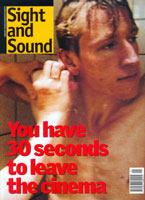
Storefront Hitchcock
USA 1997
Reviewed by Neil McCormick
Synopsis
Our synopses give away the plot in full, including surprise twists.
Cult British singer-songwriter Robyn Hitchcock stands in a shop window chatting and playing songs to an unseen audience inside the shop. He is joined intermittently by violinist Deni Bonet and guitarist Tim Keegan. A constant stream of cars and pedestrians can be seen passing behind Hitchcock's back. Occasionally someone will stop and peer through the window. During what appears to be one continuous performance, the background shifts from day to night and back again.
Review
Robyn Hitchcock is not exactly a household name. His seminal band, The Soft Boys, surfaced in the late 70s playing what he himself has described as "sedate hippie gibberish" when the music industry was being engulfed by punk rock. Confronted by widespread indifference to such singles as '(l Want to Be an) Anglepoise Lamp' they broke up in 1981, though Hitchcock has continued writing and recording in much the same vein ever since, at first backed by a band called The Egyptians but latterly completely solo. He draws on 60s psychedelic pop as the basis for melodic and emotional compositions, blending bitterness, weirdness and surreal humour in unusual settings. Some critics would argue that Hitchcock's sprawling body of work (he has released over 15 albums) remains one of the great undiscovered treasures of modern pop. But there are probably just as many who think it should remain undiscovered.
Rock superstars REM are among Hitchcock's biggest fans and their endorsement in the 80s helped introduce him to the American college audience who comprise his most loyal fan base.
It was after a typically low-key show in New York that Hitchcock was approached by Jonathan Demme about making a movie. At first glance, the very idea of a feature-length concert film being made about an obscure English eccentric by an Academy award-winning American director seems almost as absurd as one of Hitchcock's off-the-wall monologues. Attempting to explain his appeal, Hitchcock has previously commented: "My stuff is not widescreen. It doesn't look good from a distance. It's more like an etching. You have to get right up close and look at it carefully." So what is he doing on the big screen?
Winning new friends and influencing people, probably. Before the enormous success of Silence of the Lambs and Philadelphia, Demme enjoyed critical acclaim for his simple, performance-based films about author and raconteur Spalding Grey (1978's Swimming to Cambodia) and art rock group Talking Heads (1984's Stop Making Sense). Shot over four days and nights in a storefront in New York, Storefront Hitchcock follows the same stylistic pattern as the earlier films: a stripped-down minimalism that forces the viewer to focus intently on the performer. It is, in this sense, closer to the etching Hitchcock imagined than to anything routinely thought of as a widescreen experience.
Apart from a somewhat incongruous four-panelled split-screen during a guitar solo, Demme employs few of the techniques usually associated with rock videos and performance movies. There is almost no camera movement (discounting the occasional subtle zoom or slight pan), no rapid-fire cutting or extravagant staging (one song is performed by candlelight, another beneath a single electric bulb), no audience-reaction shots. The only distraction is provided by the intriguing setting. The out-of-focus, constantly moving backdrop of the city and the subtle yet peculiar shifts from day to night create a dreamlike sense of distorted time. Hitchcock truly seems to be in a world of his own, which some would say has always been the case.
Hitchcock is an acquired taste - and if you don't acquire it, the film is likely to prove unbearable. His thin, reedy voice will have some wondering whatever might have convinced him he could sing. And his epic monologues (which sometimes resemble jokes without a punchline) are as likely to baffle as many people as they delight. Yet if you have the patience to settle in, relax and slowly adjust to his peculiar point of view, Hitchcock is a revelation. Although there is much humour in his act, he is not a comedian. His songs address a huge span of ideas and emotions and Demme's close-up style allows all Hitchcock's nuance and subtlety to register.
Credits
- Producer
- Peter Saraf
- Director of Photography
- Anthony Jannelli
- Editor
- Andy Keir
- Songs
- Robyn Hitchcock
- ©Orion Pictures Corporation
- Production Companies
- Orion Pictures presents a Clinica Estetico production
- Executive Producers
- Gary Goetzman
- Edward Saxon
- Associate Producer
- Steven Shareshian
- Production Associates
- Neda Armian
- Eric Kim
- Location Supervisor
- Lauri Pitkus
- Assistant Directors
- Ron Bozman
- Kyle McCarthy
- Script Supervisor
- Anne Gyory
- Camera Operators
- Patrick Capone
- Christopher Norr
- David Knox
- Thomas Weston
- Location Visual Team
- Stephen Beatrice
- Kara Cressman
- John Souto
- Wardrobe
- Roseann Milano
- Make-up
- Carl Fullerton
- Hairstylist
- Francesca Paris
- Titles
- Tibor Kalman
- Music Editor
- Thomas Drescher
- Music Recorder
- John Hanlon
- Soundtrack
- "Devil's Radio", "1974", "Filthy Bird", "Let's Go Thundering", "I Something You", "I Am Not Me", "You and Oblivion", "All Right Yeah", "I Don't Remember Guildford", "Airscape", "Freeze", "Glass Hotel", "I'm Only You", "I Got a Message for You", "The Yip! Song" by/performed by Robyn Hitchcock
- Sound Supervisor/Mixer
- Jonathan Porath
- Sound Consultant
- Mark Wolfson
- Production Sound
- Chris Newman
- Sound Effects Editor
- Lewis Goldstein
- Creative Adviser
- Kirsten Coyne
- With
- Robyn Hitchcock
- guitar/harmonica/vocals
- Deni Bonet
- violin
- Tim Keegan
- guitar/backing vocals
- Certificate
- 12
- Distributor
- United International Pictures (UK) Ltd
- 6,942 feet
- 77 minutes 8 seconds
- Dolby
- Colour by
- DuArt
